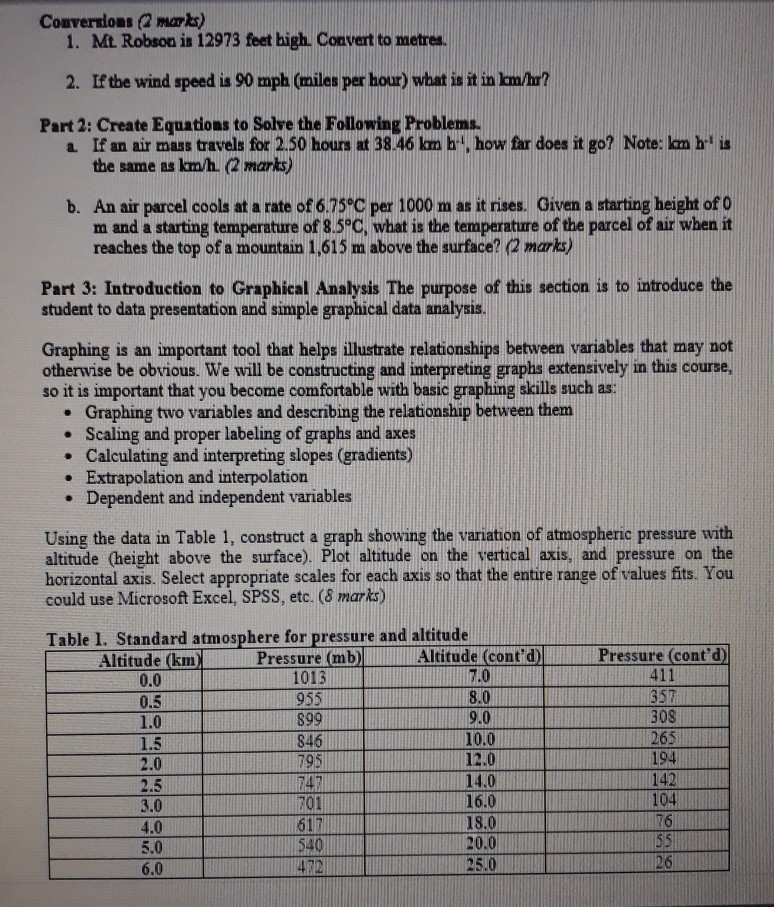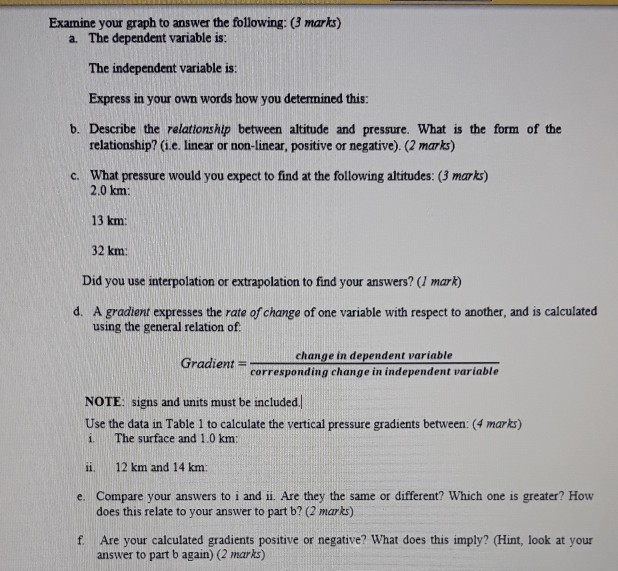Answered step by step
Verified Expert Solution
Question
1 Approved Answer
Conversions (2 marks) 1. Mt. Robson is 12973 feet high. Convert to metres. 2. If the wind speed is 90 mph (miles per hour)


Conversions (2 marks) 1. Mt. Robson is 12973 feet high. Convert to metres. 2. If the wind speed is 90 mph (miles per hour) what is it in km/hr? Part 2: Create Equations to Solve the Following Problems. a. If an air mass travels for 2.50 hours at 38.46 km h, how far does it go? Note: lam his the same as km/h. (2 marks) b. An air parcel cools at a rate of 6.75C per 1000 m as it rises. Given a starting height of 0 m and a starting temperature of 8.5C, what is the temperature of the parcel of air when it reaches the top of a mountain 1,615 m above the surface? (2 marks) Part 3: Introduction to Graphical Analysis The purpose of this section is to introduce the student to data presentation and simple graphical data analysis. Graphing is an important tool that helps illustrate relationships between variables that may not otherwise be obvious. We will be constructing and interpreting graphs extensively in this course, so it is important that you become comfortable with basic graphing skills such as: Graphing two variables and describing the relationship between them Scaling and proper labeling of graphs and axes . Calculating and interpreting slopes (gradients) Extrapolation and interpolation Dependent and independent variables . Using the data in Table 1, construct a graph showing the variation of atmospheric pressure with altitude (height above the surface). Plot altitude on the vertical axis, and pressure on the horizontal axis. Select appropriate scales for each axis so that the entire range of values fits. You could use Microsoft Excel, SPSS, etc. (8 marks) Table 1. Standard atmosphere for pressure and altitude Pressure (mb) Altitude (km) 0.0 0.5 1.0 1.5 2.0 2.5 3.0 4.0 5.0 6.0 1013 955 899 846 795 747 701 617 540 472 Altitude (cont'd) 7.0 8.0 9.0 10.0 12.0 14.0 16.0 18.0 20.0 25.0 Pressure (cont'd) 411 357 308 265 194 142 104 76 55 26 Examine your graph to answer the following: (3 marks) a. The dependent variable is: The independent variable is: Express in your own words how you determined this: b. Describe the relationship between altitude and pressure. What is the form of the relationship? (i.e. linear or non-linear, positive or negative). (2 marks) c. What pressure would you expect to find at the following altitudes: (3 marks) 2.0 km: 13 km: 32 km: Did you use interpolation or extrapolation to find your answers? (1 mark) d. A gradient expresses the rate of change of one variable with respect to another, and is calculated using the general relation of Gradient- E change in dependent variable corresponding change in independent variable NOTE: signs and units must be included. Use the data in Table 1 to calculate the vertical pressure gradients between: (4 marks) 1. The surface and 1.0 km: 11. 12 km and 14 km: e. Compare your answers to i and ii. Are they the same or different? Which one is greater? How does this relate to your answer to part b? (2 marks) f. Are your calculated gradients positive or negative? What does this imply? (Hint, look at your answer to part b again) (2 marks)
Step by Step Solution
There are 3 Steps involved in it
Step: 1
The first question that needs to be answered is the conversion of Mr Robsons height from feet to meters To convert feet to meters we use the conversion factor where 1 foot equals 03048 meters 1 Mr Rob...
Get Instant Access to Expert-Tailored Solutions
See step-by-step solutions with expert insights and AI powered tools for academic success
Step: 2

Step: 3

Ace Your Homework with AI
Get the answers you need in no time with our AI-driven, step-by-step assistance
Get Started


